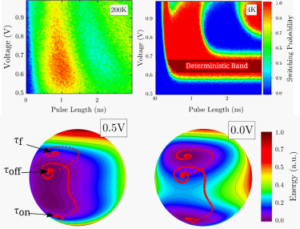Cryoelectronics has the potential to become important in high-performance computing applications and in the context of quantum computing. For low-temperature operation, it becomes imperative to reduce power dissipation, and improved device efficiency could even offset the power consumption required for cooling. In magnetic memories, voltage-controlled magnetic anisotropy (VCMA) is a promising approach to minimize the write energy per bit (Ebit), since as a purely voltage-driven effect it minimizes Joule heating losses while requiring very short switching pulses of 0.1-1 ns.

Switching probability phase diagrams and energy landscape of VCMA reversal at low temperature with deterministic reversal.
The simulated VCMA system implemented a voltage-dependent anisotropy having a coefficient ξ of 100 fJ/Vm and a constant in-plane applied magnetic field of 9 mT to induce the fast precessional switching. At 300K, conventional VCMA reversal shows regions of switching alternating with non-switching regions corresponding to a return to the initial state, as shown in the figure. According to our simulation results at 4K however, a deterministic switching voltage window appears between 0.6V and 0.7V, defining a critical switching voltage VC that is independent of the pulse width. This is a major finding, since the VCMA reversal mechanism could not be implemented without relaxing the stringent constraints on pulse width variability.
The existence of this switching band can be understood from the possibility of the magnetization to follow an optimal reversal trajectory, where the applied voltage pulse reduces the perpendicular anisotropy, bringing the magnetization closer to the in-plane direction. As seen from the energy representation projected on the unit sphere, the precessional motion induced by the sudden change of anisotropy can be such that the precession motion is enough for the magnetization to cross the equatorial plane without having enough energy to cross back to the hemisphere where it departed from.
The reason why the reversal only exists at low temperature is related to the existence of an energy saddle point, where any thermal fluctuation creates a random final state. The switching band loses its deterministic nature for temperatures above 50K with high-reliability deterministic switching only expected for sub-10K operation.
By investigating the VCMA switching for low-energy systems at temperatures below 50K, we predict the existence of a deterministic switching regime that, coupled with lower switching energies, could be advantageous as a non-volatile memory technology. Possible device heating must still be assessed to evaluate local Joule heating, which could create instabilities in the optimized reversal process.
Team: MRAM
Collaboration: Institut Neel (Grenoble)
Funding: ANR Crymco (ANR-20-CE24-0009), PEPR project PRESQUILE
Further reading: Engineering of Voltage Controlled Magnetic Anisotropy Magnetic Tunnel Junctions at Cryogenic Temperatures, P. B. Veiga, R. C. Sousa, L. D. Buda-Prejbeanu, S. Auffret, I. Joumard, L. Vila, I.-L. Prejbeanu, B. Dieny, IEEE Transactions on Magnetics, vol. 59, no. 11, pp. 1-5, Nov. 2023, Art no. 3401105, doi: 10.1109/TMAG.2023.3284503.
Open access: hal-04205048
Contact: Ricardo Sousa




